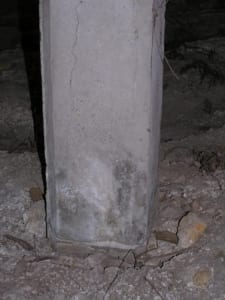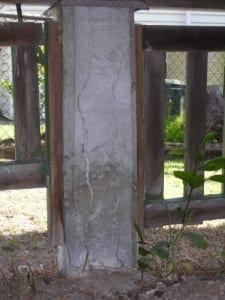Fracturing of new concrete stumps.
Learn why these new concrete stumps are fracturing. These new concrete stumps were replaced approximately 4 years before the inspection and already fracturing. Some recommendations on alternatives that are worth considering. QBIS.
Common causes of concrete stumps to fracture.
- Issues with surface and roof water drainage
- Ponding of water around bases of stumps.
- Rising damp.
- Salts in the soil.
- Reinforcing being too close to the concrete surface.
Often concrete stumps are not the correct support to use. This is dependent on different circumstances.
Alternatives to concrete stumps.
- Steel columns (preferably hot dipped galvanised) with concrete mounds to their base.
- Concrete filled and reinforced block piers.
- Better still, believe it or not, treated hardwood timber stumps.
In my experience, treated hardwood stumps are likely to outlast concrete stumps or steel columns.
Early tell tail signs of problems starting with concrete stumps:
Pooling of water and rising damp to base of stump with slight fracturing starting to appear in the concrete. The stump will continue to deteriorate, how quickly would be partially dependent upon weather conditions and extended rain periods.
Further development of concrete stump fracturing.
Deterioration of this stump is at the next stage. Its condition is not far off where pieces of concrete will start to break away. The stump is also loosing its structural integrity and may cause part of the building it is supporting to sag and cause internal cracks to develop also the floor to be uneven.
Misconception of timber stumps:
The majority of home buyers are under the misconception that the lifespan of timber stumps is not very long. Believe me, from experience, treated hardwood stumps (when correctly installed) are more likely to outlast all of the others, including you and me!
Downside of using timber stumps:
- Timber stumps are more expensive.
- Majority of homebuyers (from lack of experience) do not realise the lifespan of timber stumps.
- Timber stumps are perceived by most to require replacing sooner rather than later, even when they are relatively new, this is a wrong assumption.
- This assumption can have a negative effect when selling your house.
Worth considering when choosing stumps/columns as a replacement.
- High salt content in soil can cause concrete to fracture prematurely.
- Steel columns can rust prematurely to their bases, if incorrectly installed.
- Columns tend to cause a house to move.
- Style of house should be considered.
- Timber is more preferable with traditional houses.
Soil testing must be carried out before replacing stumps.
If replacing stumps with steel columns.
Ensure they are hot dipped galvanised, with the concrete footing extending at least 100mm above the soil level. This will help stop premature rusting around their bases.



